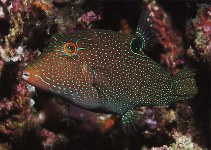| Family: |
Tetraodontidae (Puffers), subfamily: Canthigasterinae |
| Max. size: |
10 cm SL (male/unsexed) |
| Environment: |
reef-associated; marine; depth range 6 - 50 m |
| Distribution: |
Indo-West Pacific: eastern Indian Ocean and western Pacific. |
| Diagnosis: |
Dorsal soft rays (total): 8-10; Anal soft rays: 8-10. Description: Characterized by reddish brown body color with small blue-white spots on head, body and caudal fin; blue eye spokes; snout and back with blue lines; base of dorsal fin with prominent blue-edged black spot; depth of body at origin of anal fin 2.1-2.7 in SL; head length 2.3-2.7 in SL; snout length 1.3-1.5 in head length; caudal peduncle depth 1.7-2.2 in head length; slightly rounded caudal fin (Ref. 90102). |
| Biology: |
Lives in coastal to outer reef habitats from silty to pristine reefs (Ref. 48637). Occurs in clear, coral-rich areas of lagoon and seaward reefs (Ref. 37816). Sometimes solitary (Ref. 90102). Adults often in pairs along deep drop-offs while juveniles can be found in shallow estuaries (Ref. 48637). |
| IUCN Red List Status: |
Least Concern (LC); Date assessed: 08 June 2011 Ref. (130435)
|
| Threat to humans: |
harmless |
Source and more info: www.fishbase.org. For personal, classroom, and other internal use only. Not for publication.
